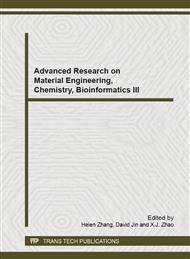[1]
IPCC.IPCC Fourth Assessment Report: Climate Change 2007. Working Croup I Report: The Physical Science Basis, 2007: 137-140.
Google Scholar
[2]
YUAN Dao-xian, LIU Zai-hua, LIN Yu-shi, et al. Karst Dynamic System in China [M]. Beijing: Geological Press, 2002: 1-3.
Google Scholar
[3]
YUAN Dao-xian, ZHANG Cheng. Karst Dynamics Theory in China and its Practice [J]. Acta Geoscientica Sinica. 2008, 29(3): 355-365.
Google Scholar
[4]
LIU Zai-hua. Contribution of Carbonate Rock Weathering to the Atomspheric CO2 Sink [J]. Carsologica Sinica. 2000, 19(4): 293-300.
Google Scholar
[5]
XU Sheng-you, JIANG Zhong-cheng. Preliminary Estimate for Karstification and CO2 Source/sink of Atmospheric Greenhouse Gases in China [J]. Chinese Science Bulletin, 1997: 953-956.
Google Scholar
[6]
Yoshimura K, Inokura Y. The Geochemical Cycle of Carbon Dioxide in a Carbonate Rock Area, A kiyo shi-dai Plateau, Yamaguchi, Southwestern Japan [A]. In: roc. 30th Int. Geol [C]. 1997, 24: 114-126.
Google Scholar
[7]
He Shi-yi, Kang Zhi-qiang, Li Qing-yan. The Utilization of Real-Time High Resolution Mornitoring Skill in Karst Carbon Sequestration: A Case of the Station in Banzhai Subterranean Stream Catchment[J]. Advances in Climate Change Research, 2011, 7(3): 157-161.
DOI: 10.3724/sp.j.1248.2012.00054
Google Scholar
[8]
LIN Hong-ying, HAN Wu-ying. Carbon Flux and Carbon Cycle of Pearl River Basin [J]. Acta Oceanologica Sinica, 1992, 14(1): 56-63.
Google Scholar
[9]
SUN Hui-guo, HAN Jing-tai, ZHANG Shu-rong, et al. The Effect of River Carbon Export Fluxes in Extraordinary Flood 05-06 on the West River [J]. Chinese Science Bulletin, 2006, 51(23): 2773-2779.
Google Scholar
[10]
DENG Zi-qiang, LIN Yu-shi, ZHANG Mei-liang, et al. Guilin Karst and geological structure [M]. Chongqing : Chongqing press, 1988: 9-19.
Google Scholar
[11]
A History of Li River Compilation Committee. A History of Li River [M]. Guangxi People Press, 2004: 5-10.
Google Scholar
[12]
Information on http: /xxfb. hydroinfo. gov. cn/nindex_dataList. jsp?type=1.
Google Scholar
[13]
Information on http: /www. weather. com. cn/weather/101300501. shtml.
Google Scholar
[14]
YU Shi, He Shi-yi, YANG Hui. Research on Carbon Source Effect of Acid Rain in a Typical Carbonate Rock Area, Guangxi[J]. Earth and Environment, 2012, 40(1): 44-49.
DOI: 10.4028/www.scientific.net/amm.295-298.314
Google Scholar
[15]
ZHANG Wei, QIN Xiao-qun, YI Lian-xing, et al. Ground Water Resource Assessment Under the Conditions to Control Ground Subsidence—A Case Study in Shanghai City [J]. Carsologica Sinica, 2004, 23(3): 169-176.
Google Scholar
[16]
TANG Wei, KANG Zhi-qiang, YIN Jian-jun1, et al. Response of Karst Carbon Sink Dynamic Behaviors to Rainfall—a Case Study in Maocun Subterranean River of Guilin[J]. Earth and Environment, 2011, 39(2): 161-166.
Google Scholar
[17]
Liu Zai-hua, W. Dreybrodt . The DBL Model and Prediction of Calcite Dissolution/Precipitation Rates Carsologica Sinica [J]. Carsologica Sinica, 1998, 17(1): 1-7.
Google Scholar
[18]
Smith S V, Hollibaugh J T. Annual Cycle and Interannual Variability of Net and Gross Ecosystem Metabolism in a Temperate Climate Embayment [J]. Ecol Monogr, 1997, 67: 509-533.
DOI: 10.1890/0012-9615(1997)067[0509:acaivo]2.0.co;2
Google Scholar
[19]
Webster I T, Parslow J S, Smith S V. Implications of spatial and temporal variation for biogeochemical budgets of estuaries [J]. Estuaries, 2000, 23(3): 341-350.
DOI: 10.2307/1353326
Google Scholar


